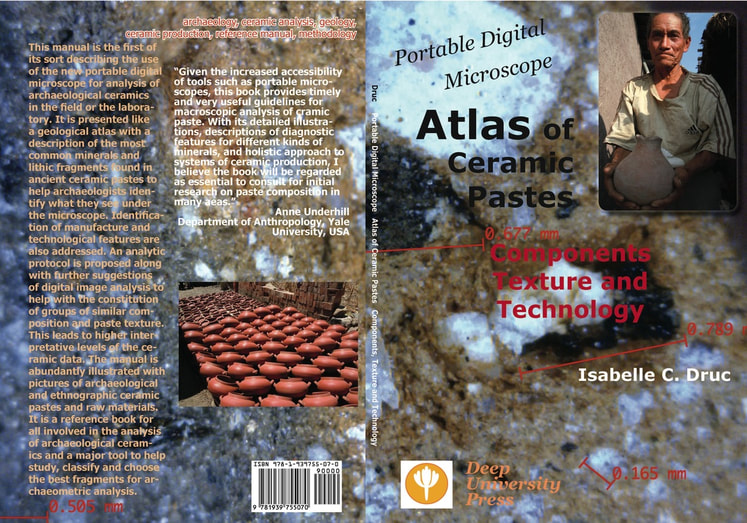Portable Digital Microscope
|
PDF E-Book Here
|
Available in print on most online retailers
PDF (19$) available on our website |
|
BEST SELLER !
This manual is the first of its sort describing the use of the new portable digital microscope for analysis of archaeological ceramics in the field or in the laboratory. It is presented like a geological atlas with a description of the most common minerals and lithic fragments found in ancient ceramic pastes to help archaeologists identify what they see under the microscope. Identification of manufacture and technological features are also addressed. An analytic protocol is proposed along with further suggestions of geology, granulometry and digital image analysis to help with the constitution of groups of similar composition and paste texture and higher interpretative levels of the ceramic data. |
The manual is abundantly illustrated with pictures of archaeological and ethnographic ceramic pastes and raw materials. It is a reference book for all involved in the analysis of archaeological ceramics and a major tool to help study, classify and choose the best fragments for archaeometric analysis. |
|
A milestone manual for the analysis of ceramic technology in the field and in the laboratory. This book, thanks to an excellent corpus of illustrations, provides useful tools for quantitative and qualitative identification of macro - components of ceramic paste. Doing so, it supports scholars to better focus the analysis and selection of the samples since the very firsts stages of the research, and it also helps to direct decisions and field procedures. Finally in this study, organized as an atlas, the author makes an admirable effort to standardize nomenclature and classifications terms, effort which will influence the work of many in the coming years.
Carolina Orsini, Curator, Museo delle Culture, Milano, Italy This timely and valuable contribution led by Dr Isabelle Druc, a renowned ceramic specialist, brings the spotlight back to the study of pottery and its myriad relationships with people. This handy guide will be useful for both students and professionals interested in learning to investigate, with precision, the composition of raw materials and their transformation by people. It enables the identification and description of their choices that inform about the critical stuff (techniques, identity, values, landscape) of ancient cultures. George Lau, Sainsbury Research Unit, University of East Anglia, UK This practical guide to macroscopic ceramic analysis will be of great value to many archaeologists, regardless of their knowledge of geology or previous experience with compositional analyses. The detailed descriptions and illustrations should be particularly helpful in the initial stages of analysis by facilitating the definition of paste groups (based on their constituent minerals, rock fragments, and textures); inferences about production techniques; and the selection of meaningful samples for more detailed petrographic and chemical studies. The book also serves as a clear, concise guide to terminology commonly used by ceramicists and geologists. Jason Sherman, Dept of Anthropology, University of Wisconsin-Milwaukee, USA |
This book is a detailed, thoroughly researched contribution to the visual analysis of ceramic paste and will be valued as a practical reference for archaeologists interested in ceramic production. Druc, with the technical collaboration of Velde and Chavez, have produced an accessible, useful guide to identifying the primary materials selected by potters and the transformations these materials undergo in the firing process. The resulting work is an important complement to the existing archaeological literature on ceramic style and chemical composition and will help to advance studies of pottery manufacture and variability.
Sarah Clayton, Dept of Anthropology, University of Wisconsin-Madison, USA Isabelle Druc and her technical collaborators Bruce Velde and Lisenia Chavez perfectly explain the somewhat abstract world of pastes and temper of ceramics seen through a portable digital microscope. The manual is an excellent methodological support for all archaeologists dealing with analysis of ceramic classification and technology, be it prehistoric or present pottery. Olga U. Gabelmann, University of Bonn, Germany An excellent addition to the study of archaeological and ethnographic ceramics. Druc and her technical collaborators were able to synthesize experience and analytical rigor in an obligatory reference work for all interested in understanding human behavior from the study of ceramic pastes. María Beatriz Cremonte, CONICET-Universidad Nacional de Jujuy, Argentina "Indispensable manual for all archaeologist interested in giving a solid and objective base to the discussion on the organization of ceramic production and ceramic distribution using the concept of chaîne opératoire. Important contribution to help the selection of samples for more advanced archaeometric analysis. " Krzysztof Makowski, Pontificia Universidad Católica del Perú |
|
|
|




